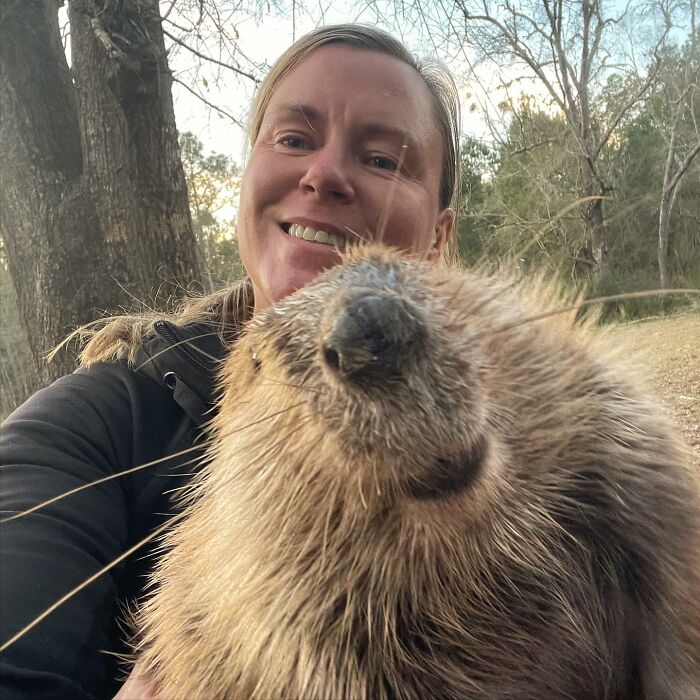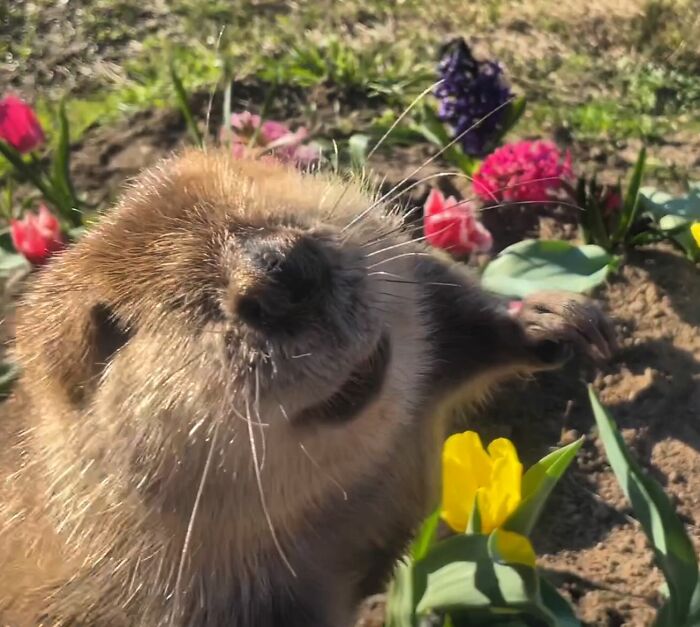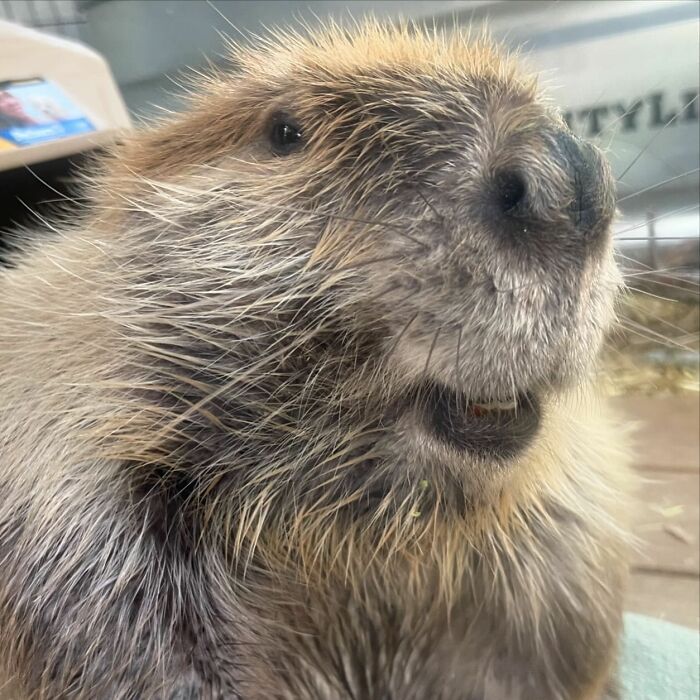
Tulip The Rescued Beaver Finds Love And Purpose As A Big Sister To A Tiny Beaver Petunia
Interview With OwnerTiming is everything, especially for our four-legged friends who have limited time on this Earth. Whether it’s a dog, a cat, or even a more exotic kind of pet, living with animals enriches our lives in countless ways…
For a lot of us, pets become family, sharing both our joys and our tough times The love and care we give them can lead to a lot of heartwarming stories, and that's the case for a beaver named Tulip too. Her journey from rescue to rehabilitation with the help of Holley is a good example of that.
More info: Instagram | youtube.com
Meet Tulip, a beaver that was rescued from a construction site in Mississippi by the staff working there
Image credits: hmuraco
Tulip the beaver’s story began in a precarious situation—found wandering and unwell at a construction site in Mississippi. Her luck changed when she was taken in by Holley Muraco, a professor at Mississippi State University and the head of Rescue Beavers.
Image credits: hmuraco
Upon finding her, Tulip was, unfortunately, sick but gradually recovered from pneumonia and bumblefoot under Holley’s care
Image credits: hmuraco
Muraco’s dedication and care brought Tulip back to health, providing her with the love, food, and security she needed. Importantly, Tulip was also given the freedom to express her natural behaviors, such as building dams using anything she could find around the house, including her collection of toys.
Image credits: hmuraco
Holley Muraco, head of Rescue Beavers, provided Tulip with the love, food, and security she needed
Image credits: hmuraco
Living with the Muraco family, Tulip is not alone. She shares her home with several other rescue beavers, helping her learn to socialize with her own species. This socialization is a crucial step in preparing Tulip for her eventual release back into her natural habitat. Tulip’s journey has also made her a valuable subject of scientific research. Studies on her physiology and behavior are shedding light on the needs and habits of beavers, offering insights that could help improve the survival and well-being of beavers in the wild. Tulip’s story is a heartwarming example of how individual animal rescues can contribute to broader conservation efforts and scientific understanding.
Image credits: hmuraco
Tulip was given the freedom to express her natural behaviors, like building dams with toys around the house
Image credits: hmuraco
When asked to describe the condition Tulip was in when first found at the construction site and the steps taken to nurse her back to health, Holley Muraco explained to Bored Panda, “Tulip was found alone by some construction/linemen workers in North Mississippi. She was alone and tiny. The only reason why a newborn beaver leaves their lodge/home is because the parents have been killed or the home destroyed. In Mississippi, beavers are classified as a nuisance species meaning they can be killed anytime. The men brought her to North Mississippi Mammal Wildlife Rehab. She was then transported to South Mississippi to Woodside Wildlife Rescue where I volunteer. I took her home and began medical treatments for pneumonia and bumblefoot. She had to live inside and receive antibiotics. Once she was healthy enough to go outside, I began introducing her to my other young beavers. Just as she was getting comfortable with living outside and visiting with the other beavers, she contracted a major skin infection from the soil. Normally this bacteria wouldn’t be an issue but because she had a weak immune system, she became infected. The infection was all over her back and she lost all the fur. She had to take more antibiotics and receive topical skin medicine. Because her back was very sensitive and needed medication, I found that premie onesies fit her perfectly. The shirts helped her back stay protected.”
Image credits: hmuraco
Living with the Muraco family, Tulip began to socialize with other rescue beavers
Image credits: hmuraco
Regarding Tulip’s natural building behavior at home and the items she uses to construct her dams, Muraco shared, “Tulip loves to make dams with plush toys. She particularly likes to put them into a pile in front of her den.”
When discussing how other rescue beavers help Tulip learn to socialize and the interactions observed between them, Muraco noted, “Because of Tulip having so many illnesses she missed out on bonding with the other beavers. By the time she was healthy enough to visit with them, she was very scared and would run away from them! They also did not seem to like Tulip. So Tulip continued socializing with her human family. This year we received Petunia as a tiny newborn. Once Petunia was strong and healthy enough to go outside we introduced Tulip to her. At first Tulip didn’t seem to understand what Petunia was but after 2-3 days, Tulip started loving the visits. Now they spend many hours together. Tulip seems to understand that Petunia is just a baby and needs to be taken care of. Tulip is being the best big sister to Petunia.”
Image credits: hmuraco
However, Tulip still faced challenges due to her initial health issues, making her wary of other beavers
Image credits: hmuraco
Holley Muraco also discussed key findings from the science papers about Tulip’s physiology and behavior and how these insights might benefit other beavers in the wild, saying, “The paper I’m working on right now is about the type of bacteria that infected Tulip’s skin, and how we treated it. This bacteria can also affect humans with weakened immune systems and could become more prevalent in the environment with increasing global temperatures. There isn’t a lot known about beaver veterinary medicine. Because they are very sensitive to antibiotics (the wrong ones can be lethal to the beaver because it kills the good gut bacteria), every time we treat a beaver for an illness we are keeping detailed notes. Beavers are hind-gut fermenters. This means that in order to digest the plant and bark materials they eat, they must have a huge number of good bacteria in their guts. I am doing a study looking at how these microbes develop in young beavers, the negative effects of antibiotics and if probiotics can be beneficial. I am also collecting data on social behavior and vocalizations. Beavers seem to rely heavily on familiar contact calls in addition to vocalizing warnings and play. Beavers are a lot smarter than people give them credit for. This was due to the old belief that smooth brains meant not-intelligent, and beavers have relatively smooth brains. We now know that smart brains come in all shapes and sizes. I am fascinated by beaver cognition and how they work together to accomplish goals.”
Image credits: hmuraco
That is until Tulip formed a special bond with Petunia, a tiny newborn beaver to whom she became a loving big sister
Image credits: hmuraco
Finally, when asked about the process and criteria for determining when Tulip will be ready to be released back into her natural environment, Muraco explained, “Many times in wildlife rehab, an animal reaches maturity and they began seeking for the wild. They are not satisfied with enclosures and begin looking for different things to experience. I will be watching Tulip closely for any signs that she is in a seeking mode. Because we are building a beaver sanctuary, each rehab beaver will go through three phases for release. The first phase are safe/secure enclosures for young beavers that they stay in for about 2 years. Phase two is a practice pond with several fenced-in acres. They will move to this area and continue to receive daily meals and have a lodge provided for them. After they live in this environment for a few months, then they will move to the final release site at the sanctuary. A large pond with a forest. We will provide a lodge at the pond but no food. The beavers will officially be released at that point.”
Not soon after their initial meeting, Tulip started mothering Petunia, helping her learn and grow in a safe environment
Image credits: hmuraco
Image credits: hmuraco
Tulip’s nurturing behavior towards Petunia highlights the social nature of beavers
Image credits: hmuraco
Image credits: hmuraco
Therefore, Tulip’s story has made her a valuable subject of scientific research on beaver physiology and behavior to help other beavers survive in the wild
Image credits: hmuraco
Image credits: hmuraco
It’s fair to say Tulip’s journey from rescue to rehabilitation highlights the importance of individual animal rescues as she happily cares for Petunia and enjoys her life to the fullest
Image credits: hmuraco
13Kviews
Share on FacebookI don't know enough about beavers to be sure of their expressions but Tulip looks so smiling, that I feel happy for her.
I don't know enough about beavers to be sure of their expressions but Tulip looks so smiling, that I feel happy for her.

 Dark Mode
Dark Mode 

 No fees, cancel anytime
No fees, cancel anytime 







































































175
39